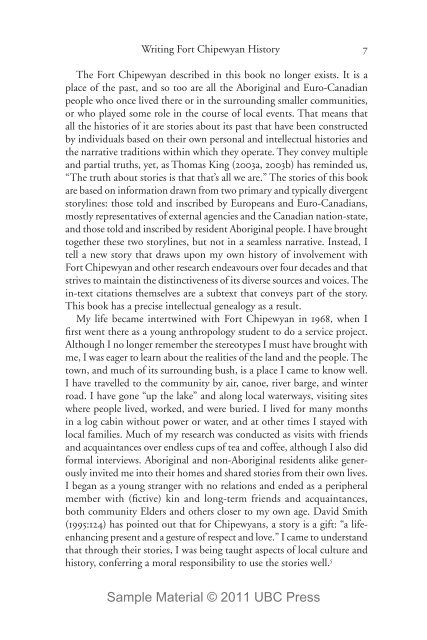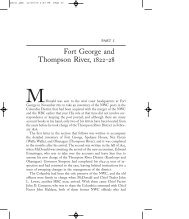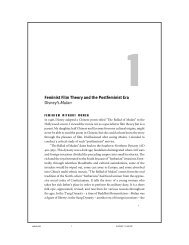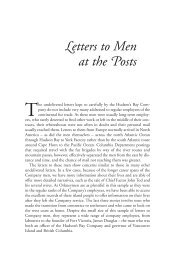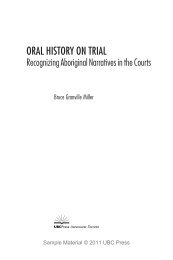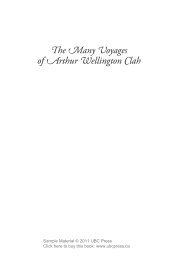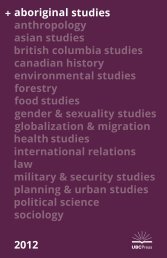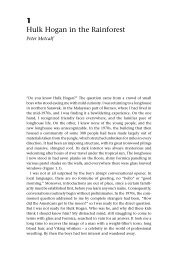Fort Chipewyan and the Shaping of Canadian History ... - UBC Press
Fort Chipewyan and the Shaping of Canadian History ... - UBC Press
Fort Chipewyan and the Shaping of Canadian History ... - UBC Press
You also want an ePaper? Increase the reach of your titles
YUMPU automatically turns print PDFs into web optimized ePapers that Google loves.
Writing <strong>Fort</strong> <strong>Chipewyan</strong> <strong>History</strong><br />
The <strong>Fort</strong> <strong>Chipewyan</strong> described in this book no longer exists. It is a<br />
place <strong>of</strong> <strong>the</strong> past, <strong>and</strong> so too are all <strong>the</strong> Aboriginal <strong>and</strong> Euro-<strong>Canadian</strong><br />
people who once lived <strong>the</strong>re or in <strong>the</strong> surrounding smaller communities,<br />
or who played some role in <strong>the</strong> course <strong>of</strong> local events. That means that<br />
all <strong>the</strong> histories <strong>of</strong> it are stories about its past that have been constructed<br />
by individuals based on <strong>the</strong>ir own personal <strong>and</strong> intellectual histories <strong>and</strong><br />
<strong>the</strong> narrative traditions within which <strong>the</strong>y operate. They convey multiple<br />
<strong>and</strong> partial truths, yet, as Thomas King (2003a, 2003b) has reminded us,<br />
“The truth about stories is that that’s all we are.” The stories <strong>of</strong> this book<br />
are based on information drawn from two primary <strong>and</strong> typically divergent<br />
storylines: those told <strong>and</strong> inscribed by Europeans <strong>and</strong> Euro-<strong>Canadian</strong>s,<br />
mostly representatives <strong>of</strong> external agencies <strong>and</strong> <strong>the</strong> <strong>Canadian</strong> nation-state,<br />
<strong>and</strong> those told <strong>and</strong> inscribed by resident Aboriginal people. I have brought<br />
toge<strong>the</strong>r <strong>the</strong>se two storylines, but not in a seamless narrative. Instead, I<br />
tell a new story that draws upon my own history <strong>of</strong> involvement with<br />
<strong>Fort</strong> <strong>Chipewyan</strong> <strong>and</strong> o<strong>the</strong>r research endeavours over four decades <strong>and</strong> that<br />
strives to maintain <strong>the</strong> distinctiveness <strong>of</strong> its diverse sources <strong>and</strong> voices. The<br />
in-text citations <strong>the</strong>mselves are a subtext that conveys part <strong>of</strong> <strong>the</strong> story.<br />
This book has a precise intellectual genealogy as a result.<br />
My life became intertwined with <strong>Fort</strong> <strong>Chipewyan</strong> in 1968, when I<br />
first went <strong>the</strong>re as a young anthropology student to do a service project.<br />
Although I no longer remember <strong>the</strong> stereotypes I must have brought with<br />
me, I was eager to learn about <strong>the</strong> realities <strong>of</strong> <strong>the</strong> l<strong>and</strong> <strong>and</strong> <strong>the</strong> people. The<br />
town, <strong>and</strong> much <strong>of</strong> its surrounding bush, is a place I came to know well.<br />
I have travelled to <strong>the</strong> community by air, canoe, river barge, <strong>and</strong> winter<br />
road. I have gone “up <strong>the</strong> lake” <strong>and</strong> along local waterways, visiting sites<br />
where people lived, worked, <strong>and</strong> were buried. I lived for many months<br />
in a log cabin without power or water, <strong>and</strong> at o<strong>the</strong>r times I stayed with<br />
local families. Much <strong>of</strong> my research was conducted as visits with friends<br />
<strong>and</strong> acquaintances over endless cups <strong>of</strong> tea <strong>and</strong> c<strong>of</strong>fee, although I also did<br />
formal interviews. Aboriginal <strong>and</strong> non-Aboriginal residents alike generously<br />
invited me into <strong>the</strong>ir homes <strong>and</strong> shared stories from <strong>the</strong>ir own lives.<br />
I began as a young stranger with no relations <strong>and</strong> ended as a peripheral<br />
member with (fictive) kin <strong>and</strong> long-term friends <strong>and</strong> acquaintances,<br />
both community Elders <strong>and</strong> o<strong>the</strong>rs closer to my own age. David Smith<br />
(1995:124) has pointed out that for <strong>Chipewyan</strong>s, a story is a gift: “a lifeenhancing<br />
present <strong>and</strong> a gesture <strong>of</strong> respect <strong>and</strong> love.” I came to underst<strong>and</strong><br />
that through <strong>the</strong>ir stories, I was being taught aspects <strong>of</strong> local culture <strong>and</strong><br />
history, conferring a moral responsibility to use <strong>the</strong> stories well. 5<br />
Sample Material © 2011 <strong>UBC</strong> <strong>Press</strong><br />
7


